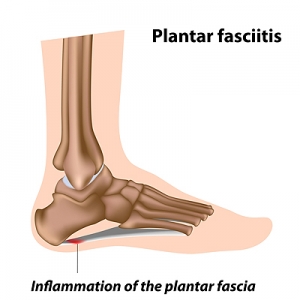
What Are the Symptoms of a Broken Ankle?
 Ankle fractures can involve one or more bones in the ankle. This type of injury can happen from a fall or from suddenly twisting the ankle. Some of the symptoms that are often associated with a broken ankle include severe pain and discomfort, and the ankle may be bruised and swollen. Relief can be found when the affected foot is frequently elevated, as this may reduce a portion of the swelling. After a proper diagnosis has been made, which typically involves having an X-ray taken to visualize the injury, a protective boot or cast may be prescribed. Daily activities may be gradually resumed, and it is beneficial to rest the foot if it becomes painful. If you have broken your ankle, it is strongly suggested that you speak with a podiatrist who can help determine the best course of treatment for you.
Ankle fractures can involve one or more bones in the ankle. This type of injury can happen from a fall or from suddenly twisting the ankle. Some of the symptoms that are often associated with a broken ankle include severe pain and discomfort, and the ankle may be bruised and swollen. Relief can be found when the affected foot is frequently elevated, as this may reduce a portion of the swelling. After a proper diagnosis has been made, which typically involves having an X-ray taken to visualize the injury, a protective boot or cast may be prescribed. Daily activities may be gradually resumed, and it is beneficial to rest the foot if it becomes painful. If you have broken your ankle, it is strongly suggested that you speak with a podiatrist who can help determine the best course of treatment for you.
Broken ankles need immediate treatment. If you are seeking treatment, contact Naim G. Shaheed, DPM from Ankle and Foot Centers of Georgia. Our doctor can provide the care you need to keep you pain-free and on your feet.
Broken Ankles
A broken ankle is experienced when a person fractures their tibia or fibula in the lower leg and ankle area. Both of these bones are attached at the bottom of the leg and combine to form what we know to be our ankle.
When a physician is referring to a break of the ankle, he or she is usually referring to a break in the area where the tibia and fibula are joined to create our ankle joint. Ankles are more prone to fractures because the ankle is an area that suffers a lot of pressure and stress. There are some obvious signs when a person experiences a fractured ankle, and the following symptoms may be present.
Symptoms of a Fractured Ankle
- Excessive pain when the area is touched or when any pressure is placed on the ankle
- Swelling around the area
- Bruising of the area
- Area appears to be deformed
If you suspect an ankle fracture, it is recommended to seek treatment as soon as possible. The sooner you have your podiatrist diagnose the fracture, the quicker you’ll be on the way towards recovery.
If you have any questions, please feel free to contact one of our offices located in Lithonia/Stonecrest and Emory/Midtown, GA . We offer the newest diagnostic and treatment technologies for all your foot care needs.
All About Broken Ankles
Broken ankles are a serious injury that can lead to an inability to walk, function, and also cause a significant amount of pain. A broken ankle is a break in one of the three bones in your body that connect at the ankle joint: the tibia, the fibula, and the talus. The tibia and fibula are your two primary leg bones that connect at the knee, which sit directly upon the talus bone. This is protected by a fibrous membrane that allows for movement in the ankle joint. A broken ankle is usually caused by the foot rolling under or twisting too far, causing one of these three bones to snap.
A broken ankle is different from an ankle sprain, which occurs when the ankle ligaments are ripped or torn but no bones have been broken. A sprain can still be very severe, causing bruising in the foot and an inability to hold your own weight, much like a broken ankle would. If you’re unable to stand, and suspect that you have a broken ankle, the first thing to do would be to get an immediate X-ray to determine the severity of the break.
A common cause of broken ankles is when the ankle is rolled over with enough pressure to break the bones. This usually happens during exercise, sports, or other physical activity. Another common cause is a fall or jump from a tall height.
One immediate treatment for pain relief is elevating the foot above your head to reduce blood flow to the injured area. You can also apply ice packs to your ankle to help reduce swelling, redness, inflammation, and pain. After these initial steps, getting a cast and staying off your feet as much as possible will aid in the recovery of the broken ankle. The less movement and stress the ankle has to endure, the more complete it will heal. A doctor can determine if surgery is needed in order to heal correctly. In these cases, an operation may be the only option to ensure the ability to walk properly again, followed by physical therapy and rehabilitation.
It is highly important to determine if surgery is needed early on, because a broken ankle can become much more severe than you realize. If not professionally treated, the broken ankle will inhibit your walking, daily functioning, and produce a large amount of pain. Treating your broken ankle early on will help prevent further damage to it.
What Issues Do Podiatrists Treat?
 A podiatrist is a doctor that is an expert in diagnosing and treating issues involving the feet and ankles. They can also prescribe medications and perform surgery. They may also work with other health care professionals to treat a variety of diseases that affect the foot. Any issue involving the bones, joints, muscles, skin, tissues, and nerves of the lower limbs can be treated by a podiatrist. These conditions can include arthritis, deformities, heel and arch pain, neuromas, sports injuries, diabetic foot issues, and skin and nail problems. For foot health education, prevention methods, or anyone who is experiencing any type of foot abnormality, seek the expertise of a podiatrist for a proper diagnosis and the best treatment plan.
A podiatrist is a doctor that is an expert in diagnosing and treating issues involving the feet and ankles. They can also prescribe medications and perform surgery. They may also work with other health care professionals to treat a variety of diseases that affect the foot. Any issue involving the bones, joints, muscles, skin, tissues, and nerves of the lower limbs can be treated by a podiatrist. These conditions can include arthritis, deformities, heel and arch pain, neuromas, sports injuries, diabetic foot issues, and skin and nail problems. For foot health education, prevention methods, or anyone who is experiencing any type of foot abnormality, seek the expertise of a podiatrist for a proper diagnosis and the best treatment plan.
If you are experiencing pain in the feet or ankles, don’t join the stubborn majority refusing treatment. Feel free to contact Naim G. Shaheed, DPM from Ankle and Foot Centers of Georgia. Our doctor can provide the care you need to keep you pain-free and on your feet.
What Is a Podiatrist?
Someone would seek the care of a podiatrist if they have suffered a foot injury or have common foot ailments such as heal spurs, bunions, arch problems, deformities, ingrown toenails, corns, foot and ankle problems, etc.
Podiatric Treatment
A podiatrist will treat the problematic areas of the feet, ankle or lower leg by prescribing the following:
- Physical therapy
- Drugs
- Orthotic inserts or soles
- Surgery on lower extremity fractures
A common podiatric procedure a podiatrist will use is a scanner or force plate which will allow the podiatrist to know the designs of orthotics. Patients are then told to follow a series of tasks to complete the treatment. The computer will scan the foot a see which areas show weight distribution and pressure points. The podiatrist will read the analysis and then determine which treatment plans are available.
If you have any questions please feel free to contact one of our offices located in Lithonia/Stonecrest and Emory/Midtown, GA . We offer the newest diagnostic and treatment technologies for all your foot and ankle needs.
What is a Podiatrist?
The branch of medicine that is focused on the treatment, diagnosis, and study of disorders of the lower leg, ankle and foot is referred to as podiatry. Because people often spend a great deal of their time on their feet, many problems in this area can occur. A person seeks help from the field of podiatry when they need treatment for heel spurs, bunions, arch problems, deformities, ingrown toenails, corns, foot and ankle problems, infections, and problems with the foot that are related to diabetes and additional diseases.
To treat problems of the foot, ankle or lower leg, a podiatrist may prescribe physical therapy, drugs, perform surgery, or set fractures. Individuals may also be recommended to wear corrective shoe inserts, custom-made shoes, plaster casts and strappings in order to correct deformities.
When trying to gather information on a patient problem, a scanner or force plate may be used in order to design orthotics. During this procedure, patients are told to walk across a plate that is connected to a computer; the computer then takes a scan of the foot and indicates weight distribution and pressure points. The computer readouts will give the podiatrist information to help them determine the correct treatment plans.
Diagnosis is also provided through laboratory tests and x-rays. Through the foot, the first signs of serious problems such as heart disease, diabetes and arthritis can show up. For example, individuals that have diabetes may frequently have problems such as infections and foot ulcers because they experience poor circulation in the foot area. A podiatrist can then have consultations with patients when symptoms arise. Referrals will then be made to specialists that handle the greater health problems.
Some podiatrists have their own independent, private practices or clinics where they have a small staff and administrative personnel. Many podiatrists work within group practices. They usually spend time performing surgery in ambulatory surgical centers or hospitals, or visit patients in nursing homes. Podiatrists typically spend between 30 to 60 hours of week working. Some podiatrists specialize in public health, orthopedics, surgery, or primary care. Other fields include specialties in geriatrics, dermatology, pediatrics, diabetic foot care and sports medicine.
Some podiatrist specialists complete extra training in the area of foot and ankle reconstruction that results from the effects of physical trauma or diabetes. There are also surgeons that perform surgery of a cosmetic nature to correct bunions and hammertoes.
Reasons for Developing Plantar Fasciitis
 The pain and discomfort that is found in plantar fasciitis is located in the heel and arch area of the foot. It develops as a result of inflammation that affects the plantar fascia. The plantar fascia is a band of tissue that connects the heel to the toes and runs along the bottom of the foot. The contributing factors for developing plantar fasciitis can include standing on hard surfaces for the majority of the day and wearing uncomfortable shoes, such as high heels. Additionally, patients who have gained weight may develop this ailment, and it can affect people who have low or high arches. The pain that accompanies plantar fasciitis can be debilitating, and it is strongly suggested that you are under the care of a podiatrist if you are experiencing heel pain.
The pain and discomfort that is found in plantar fasciitis is located in the heel and arch area of the foot. It develops as a result of inflammation that affects the plantar fascia. The plantar fascia is a band of tissue that connects the heel to the toes and runs along the bottom of the foot. The contributing factors for developing plantar fasciitis can include standing on hard surfaces for the majority of the day and wearing uncomfortable shoes, such as high heels. Additionally, patients who have gained weight may develop this ailment, and it can affect people who have low or high arches. The pain that accompanies plantar fasciitis can be debilitating, and it is strongly suggested that you are under the care of a podiatrist if you are experiencing heel pain.
Plantar fasciitis can be very painful and inconvenient. If you are experiencing heel pain or symptoms of plantar fasciitis, contact Naim G. Shaheed, DPM from Ankle and Foot Centers of Georgia. Our doctor can provide the care you need to keep you pain-free and on your feet.
What Is Plantar Fasciitis?
Plantar fasciitis is the inflammation of the thick band of tissue that runs along the bottom of your foot, known as the plantar fascia, and causes mild to severe heel pain.
What Causes Plantar Fasciitis?
- Excessive running
- Non-supportive shoes
- Overpronation
- Repeated stretching and tearing of the plantar fascia
How Can It Be Treated?
- Conservative measures – anti-inflammatories, ice packs, stretching exercises, physical therapy, orthotic devices
- Shockwave therapy – sound waves are sent to the affected area to facilitate healing and are usually used for chronic cases of plantar fasciitis
- Surgery – usually only used as a last resort when all else fails. The plantar fascia can be surgically detached from the heel
While very treatable, plantar fasciitis is definitely not something that should be ignored. Especially in severe cases, speaking to your doctor right away is highly recommended to avoid complications and severe heel pain. Your podiatrist can work with you to provide the appropriate treatment options tailored to your condition.
If you have any questions please feel free to contact one of our offices located in Lithonia/Stonecrest and Emory/Midtown, GA . We offer the newest diagnostic and treatment technologies for all your foot and ankle needs.
Plantar Fasciitis
The plantar fascia is a connective tissue in the heel that stretches across the bottom length of your foot. Plantar fasciitis occurs when the connective tissue becomes inflamed, causing heel pain and discomfort during physical activity. Although the condition is completely treatable, traditional methods can take up to a year to start becoming effective.
Plantar fasciitis is caused by a number of everyday activities, so understanding the condition is important for managing and treating it. One of the most common causes of plantar fasciitis is excessive running, especially with improper fitting or non-supportive shoes. Too much exercise can lead to the plantar fascia being overworked and overstretched, which can cause tears in the tissue. Along with improper fitting shoes, pronation, the rolling of the feet inward, is a common cause of plantar fasciitis. If not treated properly, the plantar fascia becomes overstretched and starts to tear, causing inflammation.
Despite the common causes of plantar fasciitis, there are many different treatment options. For less severe cases, conservative home remedies include taking anti-inflammatory drugs to alleviate pain, applying ice packs to the bottom of your foot and heel, slowly stretching and exercising your feet to re-strengthen the tissue, and using orthotic devices are all ways to help manage your plantar fasciitis.
For more severe cases, shockwave therapy has become a common solution for plantar fasciitis. Shockwave therapy can effectively break up the tissue on the bottom of your foot which facilitates healing and regeneration. This fights the chronic pain caused by plantar fasciitis. Even if this doesn’t work, surgery is always a final option. Surgery on the tissue itself can be done to permanently correct the issue and stop the inflammation and pain in your heels.
No matter what the case may be, consulting your podiatrist is the first and best step to recovery. Even the slightest amount of heel pain could be the first stage of plantar fasciitis. Untreated symptoms can lead to the tearing and overstretching of tissue. Because the tearing of tissue can be compounded if it remains ignored, it can evolve into a severe case. The solution is early detection and early treatment. Talk to your podiatrist about the possibilities of plantar fasciitis if you’re experiencing heel pain.
What is Metatarsalgia?
 Metatarsalgia refers to pain that is in the ball of the foot. This term refers to the metatarsal bones that are in this area, and the pain is often a result of repetitive bursts that occur in this part of the foot and eventually overload the metatarsals. Pain over the top and sole of the foot between the 2nd and 4th toes is the most common sign of metatarsalgia. Often, this pain is worsened by pushing off while walking or running. If you are experiencing pain in the forefoot that may be metatarsalgia, it is important to consult with a podiatrist. A podiatrist will check to make sure there is no other damage in the area and prescribe a treatment method. Treatment usually starts with rest and icing the foot, and may include medicine or orthotics.
Metatarsalgia refers to pain that is in the ball of the foot. This term refers to the metatarsal bones that are in this area, and the pain is often a result of repetitive bursts that occur in this part of the foot and eventually overload the metatarsals. Pain over the top and sole of the foot between the 2nd and 4th toes is the most common sign of metatarsalgia. Often, this pain is worsened by pushing off while walking or running. If you are experiencing pain in the forefoot that may be metatarsalgia, it is important to consult with a podiatrist. A podiatrist will check to make sure there is no other damage in the area and prescribe a treatment method. Treatment usually starts with rest and icing the foot, and may include medicine or orthotics.
Foot Pain
Foot pain can be extremely painful and debilitating. If you have a foot pain, consult with Naim G. Shaheed, DPM from Ankle and Foot Centers of Georgia. Our doctor will assess your condition and provide you with quality foot and ankle treatment.
Causes
Foot pain is a very broad condition that could be caused by one or more ailments. The most common include:
- Bunions
- Hammertoes
- Plantar Fasciitis
- Bone Spurs
- Corns
- Tarsal Tunnel Syndrome
- Ingrown Toenails
- Arthritis (such as Gout, Rheumatoid, and Osteoarthritis)
- Flat Feet
- Injury (from stress fractures, broken toe, foot, ankle, Achilles tendon ruptures, and sprains)
- And more
Diagnosis
To figure out the cause of foot pain, podiatrists utilize several different methods. This can range from simple visual inspections and sensation tests to X-rays and MRI scans. Prior medical history, family medical history, and any recent physical traumatic events will all be taken into consideration for a proper diagnosis.
Treatment
Treatment depends upon the cause of the foot pain. Whether it is resting, staying off the foot, or having surgery; podiatrists have a number of treatment options available for foot pain.
If you have any questions, please feel free to contact one of our offices located in Lithonia/Stonecrest and Emory/Midtown, GA . We offer the newest diagnostic and treatment technologies for all your foot care needs.
Foot Pain
Our feet are arguably the most important parts of our bodies because they are responsible for getting us from place to place. However, we often don’t think about our feet until they begin to hurt. If you have pain in your feet, you need to first determine where on the foot you are experiencing it to get to the root of the problem. The most common areas to feel pain on the foot are the heel and the ankle.
Heel pain is most commonly attributed to a condition called plantar fasciitis. Plantar fasciitis occurs when the plantar fascia, which is the band of tough tissue connecting the heel bone to the toes becomes inflamed. Plantar fasciitis pain is usually worse in the morning, and it tends to go away throughout the day. If you have plantar fasciitis, you should rest your foot and do heel and foot muscles stretches. Wearing shoes with proper arch support and a cushioned sole has also been proven to be beneficial.
Some common symptoms of foot pain are redness, swelling, and stiffness. Foot pain can be dull or sharp depending on its underlying cause. Toe pain can also occur, and it is usually caused by gout, bunions, hammertoes, ingrown toenails, sprains, fractures, and corns.
If you have severe pain in your feet, you should immediately seek assistance from your podiatrist for treatment. Depending on the cause of your pain, your podiatrist may give you a variety of treatment options.
Teaching Children Proper Foot Care at an Early Age
 It is important for children to learn at an early age the necessity of properly taking care of their feet. A daily routine may consist of washing them thoroughly, especially between the toes, followed by completely drying the feet. Shoes may last longer when they are aired out after wearing them, and it can help to wash sneakers often, which can keep them soft. The medical condition that is known as athlete’s foot is generally accompanied by symptoms that can include itchy skin and small blisters. This condition can cause pain and discomfort, and may be common among children. It is considered to be contagious, and parents can teach their children to wear appropriate shoes while in public pools and surrounding areas, where fungus is more commonly spread. If you would like additional information about the importance of maintaining your child’s foot health, it is suggested that you consult with a podiatrist.
It is important for children to learn at an early age the necessity of properly taking care of their feet. A daily routine may consist of washing them thoroughly, especially between the toes, followed by completely drying the feet. Shoes may last longer when they are aired out after wearing them, and it can help to wash sneakers often, which can keep them soft. The medical condition that is known as athlete’s foot is generally accompanied by symptoms that can include itchy skin and small blisters. This condition can cause pain and discomfort, and may be common among children. It is considered to be contagious, and parents can teach their children to wear appropriate shoes while in public pools and surrounding areas, where fungus is more commonly spread. If you would like additional information about the importance of maintaining your child’s foot health, it is suggested that you consult with a podiatrist.
Making sure that your children maintain good foot health is very important as they grow. If you have any questions, contact Naim G. Shaheed, DPM of Ankle and Foot Centers of Georgia. Our doctor can provide the care you need to keep you pain-free and on your feet.
Keeping Children's Feet Healthy
Having healthy feet during childhood can help prevent medical problems later in life, namely in the back and legs. As children grow, their feet require different types of care. Here are some things to consider...
Although babies do not walk yet, it is still very important to take care of their feet.
Avoid putting tight shoes or socks on his or her feet.
Allow the baby to stretch and kick his or her feet to feel comfortable.
As a toddler, kids are now on the move and begin to develop differently. At this age, toddlers are getting a feel for walking, so don’t be alarmed if your toddler is unsteady or ‘walks funny’.
As your child gets older, it is important to teach them how to take care of their feet.
Show them proper hygiene to prevent infections such as fungus.
Be watchful for any pain or injury.
Have all injuries checked by a doctor as soon as possible.
Comfortable, protective shoes should always be worn, especially at play.
If you have any questions please feel free to contact one of our offices located in Lithonia/Stonecrest and Emory/Midtown, GA . We offer the newest diagnostic and treatment technologies for all your foot and ankle needs.















